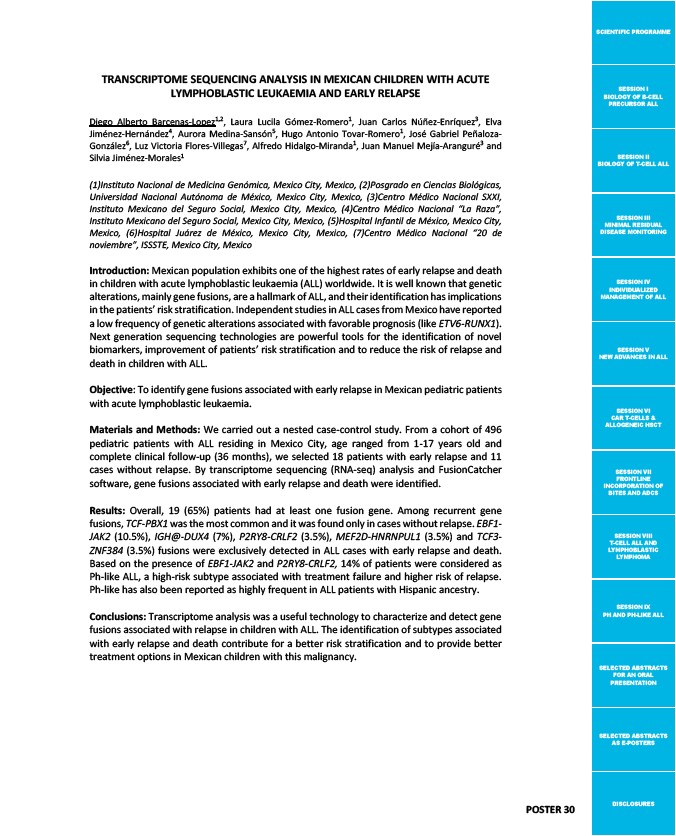
SCIENTIFIC PROGRAMME
SESSION I
BIOLOGY OF B-CELL
PRECURSOR ALL
SESSION II
BIOLOGY OF T-CELL ALL
SESSION III
MINIMAL RESIDUAL
DISEASE MONITORING
SESSION IV
INDIVIDUALIZED
MANAGEMENT OF ALL
SESSION V
NEW ADVANCES IN ALL
SESSION VI
CAR T-CELLS &
ALLOGENEIC HSCT
SESSION VII
FRONTLINE
INCORPORATION OF
BITES AND ADCS
SESSION VIII
T-CELL ALL AND
LYMPHOBLASTIC
LYMPHOMA
SESSION IX
PH AND PH-LIKE ALL
SELECTED ABSTRACTS
FOR AN ORAL
PRESENTATION
SELECTED ABSTRACTS
AS E-POSTERS
DISCLOSURES
TRANSCRIPTOME SEQUENCING ANALYSIS IN MEXICAN CHILDREN WITH ACUTE
LYMPHOBLASTIC LEUKAEMIA AND EARLY RELAPSE
Diego Alberto Barcenas-Lopez1,2, Laura Lucila Gómez-Romero1, Juan Carlos Núñez-Enríquez3, Elva
Jiménez-Hernández4, Aurora Medina-Sansón5, Hugo Antonio Tovar-Romero1, José Gabriel Peñaloza-
González6, Luz Victoria Flores-Villegas7, Alfredo Hidalgo-Miranda1, Juan Manuel Mejía-Aranguré3 and
Silvia Jiménez-Morales1
(1)Instituto Nacional de Medicina Genómica, Mexico City, Mexico, (2)Posgrado en Ciencias Biológicas,
Universidad Nacional Autónoma de México, Mexico City, Mexico, (3)Centro Médico Nacional SXXI,
Instituto Mexicano del Seguro Social, Mexico City, Mexico, (4)Centro Médico Nacional “La Raza”,
Instituto Mexicano del Seguro Social, Mexico City, Mexico, (5)Hospital Infantil de México, Mexico City,
Mexico, (6)Hospital Juárez de México, Mexico City, Mexico, (7)Centro Médico Nacional “20 de
noviembre”, ISSSTE, Mexico City, Mexico
Introduction: Mexican population exhibits one of the highest rates of early relapse and death
in children with acute lymphoblastic leukaemia (ALL) worldwide. It is well known that genetic
alterations, mainly gene fusions, are a hallmark of ALL, and their identification has implications
in the patients’ risk stratification. Independent studies in ALL cases from Mexico have reported
a low frequency of genetic alterations associated with favorable prognosis (like ETV6-RUNX1).
Next generation sequencing technologies are powerful tools for the identification of novel
biomarkers, improvement of patients’ risk stratification and to reduce the risk of relapse and
death in children with ALL.
Objective: To identify gene fusions associated with early relapse in Mexican pediatric patients
with acute lymphoblastic leukaemia.
Materials and Methods: We carried out a nested case-control study. From a cohort of 496
pediatric patients with ALL residing in Mexico City, age ranged from 1-17 years old and
complete clinical follow-up (36 months), we selected 18 patients with early relapse and 11
cases without relapse. By transcriptome sequencing (RNA-seq) analysis and FusionCatcher
software, gene fusions associated with early relapse and death were identified.
Results: Overall, 19 (65%) patients had at least one fusion gene. Among recurrent gene
fusions, TCF-PBX1 was the most common and it was found only in cases without relapse. EBF1-
JAK2 (10.5%), IGH@-DUX4 (7%), P2RY8-CRLF2 (3.5%), MEF2D-HNRNPUL1 (3.5%) and TCF3-
ZNF384 (3.5%) fusions were exclusively detected in ALL cases with early relapse and death.
Based on the presence of EBF1-JAK2 and P2RY8-CRLF2, 14% of patients were considered as
Ph-like ALL, a high-risk subtype associated with treatment failure and higher risk of relapse.
Ph-like has also been reported as highly frequent in ALL patients with Hispanic ancestry.
Conclusions: Transcriptome analysis was a useful technology to characterize and detect gene
fusions associated with relapse in children with ALL. The identification of subtypes associated
with early relapse and death contribute for a better risk stratification and to provide better
treatment options in Mexican children with this malignancy.
POSTER 30